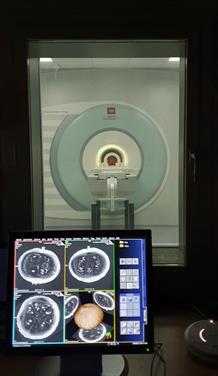A pumpkin: this unusual object was chosen for its multiple textures by CEA engineers and researchers to make the first images with the world's most powerful 11.7 T human whole-body MRI of the Iseult project, installed at NeuroSpin at CEA-Paris-Saclay.
With a resolution of 400 microns in three dimensions, the images of the cucurbit prefigure the prowess that the scientific and technical teams of the CEA and their partners will be able to achieve in order to probe the human brain, for the benefit of fundamental research, cognitive sciences and in understanding brain pathologies. These first acquisitions validate the entire process that has made it possible, thanks to multiple technological breakthroughs, to transform an "outstanding" magnet into an MRI machine.
« The development of the Iseult project magnet has been an exceptional human, technological and industrial adventure. To see it come to fruition with the achievement of the magnet nominal field strength - 11.7 T - followed by these first high-resolution images, which are so promising, is a real source of pride for all of us » enthuses Anne-Isabelle Etienvre, director of CEA-Irfu.

These images are the culmination of 20 years of research that have enabled us to apply innovative technological developments made for CERN to medical research. This achievement is also the fruit of a Franco-German cooperation initiated in 2006, which involved academic partners, the University of Freiburg, and industrial partners, Bruker Biospin, Alstom, now part of General Electric, Guerbet and Siemens Healthineers. Siemens Healthineers has installed the MAGNETOM 11.7 T imaging equipment that has enabled the acquisition of these first images.
“With our 7 Tesla scanner MAGNETOM Terra firmly established for clinical use and our recent introduction of 0.55 Tesla High-V MRI, it is exciting to me to keep pushing the envelope even further. I am very happy that our joint team effort pays off now. We can’t wait to see what exciting new insights imaging at 11.7T will bring and to continue our long-standing innovation track at ultra-high-field”, says Arthur Kaindl, Head of MRI at Siemens Healthineers.
Nevertheless, several optimizations still need to be carried out to obtain images of a quality approaching a resolution of 100 to 200 microns at 11.7 T. Before the Iseult MRI is fully commissioned and the first in vivo images are acquired on a human subject, the teams will be working in the coming months on the final verifications of the imaging equipment and the first tests of the radiofrequency coil developed specifically for the Iseult project. In 2022, the European Aroma project will be further deployed to develop a methodology for the optimal operation of this MRI. Finally, once the health authorities have given their approval, the new MRI will be used to conduct research with the help of volunteers.
For Stanislas Dehaene, director of NeuroSpin, the neuroimaging platform at CEA-Paris-Saclay, « Thanks to this extraordinary MRI, our researchers are looking forward to studying the anatomical and structural organization of the brain in greater detail. This work will undoubtedly lead to major clinical applications ».
An extraordinary magnet at the heart of the MRI from the Iseult project
132 tons, 5 m in length, 5 m in external diameter and 90 cm in internal diameter (to allow the passage of a whole human body): these are the extraordinary dimensions of the magnet of the Iseult project, which reaches a nominal magnetic field of 11.7 teslas, much more powerful than that of standard hospital MRIs (typically 1.5 or 3 T). To achieve this field, the magnet is powered by a current of 1,500 amps. The conductor coils are permanently cooled by helium in a superfluid state at 1.8 Kelvin (-271.35°C). The magnetic field of 11.7 T is a world record in the field of MRI for such a volume, and an absolute record with this type of superconductor material.
This magnet was designed by a CEA team that had already designed Tokamak magnets and the magnets for the CERN detectors that led to the discovery of the Higgs boson. Its manufacture began in 2010 in the Alstom - now GE - plant in Belfort and will take six years. Nearly four years of installation and fine-tuning work to achieve the required field homogeneity will then have been necessary before it is ready for operational use in 2021.